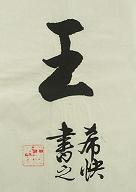Origin of calligraphy - ancient Chinese Calligraphy history
When did calligraphy originate? This question probably interests everyone who wishes to study calligraphy. No precise date is given in ancient Chinese history. Legend says that during the reign of the Yellow Emperor a man named Cang Jie invented the Chinese language. Calligraphy came after invention of the language. We may attribute- the invention to 4,600 years ago, but this is only a legendary tale and may not be credible. What is interesting, however, is that archaeological discoveries since the birth of new China have authenticated that 4,500 years ago language came into existence in China. It follows that calligraphy entered an embryonic stage then.  Left photo is an ancient sunrise painting. The painting was a design inscribed on a big-mouthed pottery jar-a sacrificial vessel to the sun by primitive Chinese forebears in Shandong during the period when the Dawenkou culture thrived (4000-2000 BC).
Left photo is an ancient sunrise painting. The painting was a design inscribed on a big-mouthed pottery jar-a sacrificial vessel to the sun by primitive Chinese forebears in Shandong during the period when the Dawenkou culture thrived (4000-2000 BC).
This painting, or design, consists of three parts: upper, middle and bottom. The upper part is a round sun. Below it is a moon. A huge mountain with five peaks is at the bottom. Some experts think this might be the original of![]() (dan4) "sunrise", with the sun above a cloud (or perhaps above the setting moon), on top of a mountain. The same character appears in inscriptions on bone or tortoise shell, on ancient bronze vessels, in lesser seal characters, in official script and in regular script in later times. The origin of the character is the picture. From the angle of calligraphy we might regard the sun in the picture as round as a circle. The moon is a bit wavelike. The mountain is drawn with the brush exerting strength. The shapes of the moon and the mountain are well proportioned on left and right, imparting a sense of balance. The arrangement is small on top and big on the bottom. The top is round, the bottom flat. This gives one a sense of steadiness. As calligraphy, the character is well written insofar as technique, structure and presentation are concerned. The character has a strong rhythmic sense.
(dan4) "sunrise", with the sun above a cloud (or perhaps above the setting moon), on top of a mountain. The same character appears in inscriptions on bone or tortoise shell, on ancient bronze vessels, in lesser seal characters, in official script and in regular script in later times. The origin of the character is the picture. From the angle of calligraphy we might regard the sun in the picture as round as a circle. The moon is a bit wavelike. The mountain is drawn with the brush exerting strength. The shapes of the moon and the mountain are well proportioned on left and right, imparting a sense of balance. The arrangement is small on top and big on the bottom. The top is round, the bottom flat. This gives one a sense of steadiness. As calligraphy, the character is well written insofar as technique, structure and presentation are concerned. The character has a strong rhythmic sense.
Let us look at another calligraphic work by primitive Chinese forebears-an inscription on pottery discovered in the ruins of the ancient Longshan culture in Dinggong Village, Zouping County, Shan-dong Province, in January 1992. There are five lines with eleven characters on the pottery piece. The lines seem to flow. The arrangement is good and well composed. The design on the Dawenkou culture pottery jar is a mixture of painting and calligraphy, difficult to distinguish, but the language on the Longshan culture pottery piece may be described as mature. To date, it is the most ancient calligraphic work in China. It may well be described as the embryo of calligraphy in seal characters. It is 4,300 years old.
Chinese calligraphy is at least four thousand years old, based on legendary tales and on textual criticism in archaeology.
The two primitive calligraphic works are both inscribed on pottery pieces by sharp tools. Therefore in the opinion of calligraphic historians they are the earliest works written by means of sharp tools-a sort of metal brush, or "hard" brush as the Chinese say.
Surviving writings made with a metal tool are much older than surviving writings made with a brush, but of course this is because the harder, incised materials have lasted, while any brush writings on materials such as bamboo books, wooden slats, silk, animal skins, etc. have long since disintegrated. The inscriptions on bone or tortoise shell of the Shang Dynasty are outstanding examples of metal-tool calligraphy.

True enough, these inscriptions are outstanding examples of ancient Chinese calligraphy written by means of a metal tool, but it would not be correct to say that all inscriptions on bone or tortoise shell were done by means of a metal tool. Be ore being inscribed with a metal tool, some were first drawn by a brush. They were inscribed on bone or shell later. The style of the calligraphy on the pottery piece in Dinggong Village is too complicated to have been inscribed directly on the pottery with a sharp tool. It is possible that something like a brush was used to write the calligraphy. In other words, calligraphy written by means of the brush also has a history of over four thousand years in China.

Book References Guo, Bonan 1995. Gate to Chinese Calligraphy. Beijing: Foreign Languages Press.
Source : http://www.chinavoc.com/arts/calligraphy
